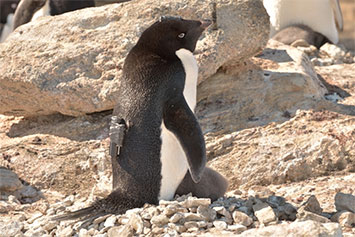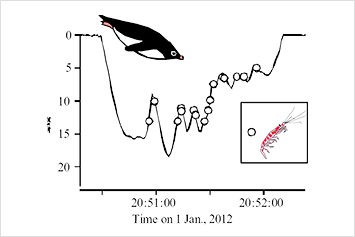National Institute of Polar Research
Penguins forage optimally as classic theory predicts
How can animals maximize food intake when food is patchily distributed? A classic theory proposed about 40 years ago, called the marginal value theorem, formulates optimal patch residence time in response to patch quality. Despite its great influence, the theory has been inadequately tested in the wild due to technical difficulties in monitoring foraging behavior of free-ranging predators. Using animal-borne accelerometers and video cameras, we simultaneously recorded diving behavior of penguins and the timings of krill capture events. We provide supports for the theory by demonstrating that penguins flexibly change their behavior in response to patch quality at multiple timescales.
Journal: Proceedings of the Royal Society B
Title: Testing optimal foraging theory in a penguin-krill system
Authors: Yuuki Y. Watanabe, Motohiro Ito, and Akinori Takahashi / National Institute of Polar Research

(Fig. 1) An Adélie penguin fitted with a video camera and an accelerometer (on the back) and an accelerometer (on the head).

(Fig. 2) Diving behavior and the timing of krill captures by an Adélie penguin.

(Fig. 3) Dive durations increased with short-term (i.e., dive-scale) patch quality (top panel), but decreased with long-term (i.e., bout-scale) patch quality (bottom panel). Patch quality was quantified by the rate of krill captures. This result matches the predictions of the classic marginal value theorem, demonstrating that penguins behave optimally at multiple timescales to maximize total food intake.








